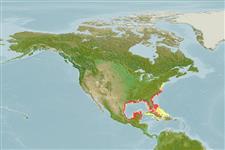>
Siluriformes (Catfishes) >
Ariidae (Sea catfishes) > Ariinae
Etymology: Ariopsis: Greek, ari = very, strength, superiority + Greek, opsis = appearance (Ref. 45335).
More on author: Linnaeus.
Environment: milieu / climate zone / depth range / distribution range
экология
морской; солоноватоводный ассоциированный с рифами. Subtropical; 43°N - 18°N, 98°W - 68°W
Western Atlantic: Massachusetts and northern Gulf of Mexico to southern Florida in USA and Mexico.
Length at first maturity / Size / Вес / Возраст
Maturity: Lm ?, range 13 - ? cm
Max length : 70.0 cm TL самец/пол неопределен; (Ref. 40637); common length : 25.0 cm TL самец/пол неопределен; (Ref. 3265); наибольший вес (опубликованные данные): 5.5 kg (Ref. 7251)
This species is distinguished from its congeners by the following characters: gill rakers on the first and second gill arches 29-32; osseous medial groove present; fleshy medial groove of neurocranium conspicuous and long, always surpassing the posterior margin of eyes; lateral margin of sphenotic notched, narrower medially than anteriorly; pterotic lateral margin smoothly convex; lateral margin of sphenotic notched, narrower medially than anteriorly; mouth 9.1-11.5% SL; close anterior nostrils 4.6-6.4% SL, close posterior nostrils 4.2-7.1% SL; mesethmoid median portion narrow, mesethmoid medial notch narrow and deep; gill rakers on the first gill arch 13–15, rarely 16; external posterior branch of lateral ethmoid columnar and thin; fenestra delimited by mesethmoid and lateral ethmoid conspicuous (Ref. 116660).
Adults inhabit continental waters and enter estuaries. Found in turbid waters over muddy bottoms. Males incubate eggs in the mouth (Ref. 205). Commonly captured from catwalks, bridges and piers, particularly in passes and inland waterways. Edible, but generally not consumed (Ref. 7251).
Males carry the eggs in the mouth (Ref. 205).
Marceniuk, A.P., A.P. Acero, R. Cooke and R. Betancur-R, 2017. Taxonomic revision of the new world genus Ariopsis Gill (Siluriformes: Ariidae), with description of two new species. Zootaxa 4290(1):1-42. (Ref. 116660)
Статус Красного Списка МСОП (Ref. 130435: Version 2024-2)
Угроза для людей
Traumatogenic (Ref. 58010)
Использование человеком
рыболовство: не имеет хозяйственного значения; объект спортивного рыболовства: да
дополнительная информация
инструменты
Специальные отчеты
Скачать в формате XML
ресурсы в Интернет
Estimates based on models
Preferred temperature (Ref.
123201): 23.3 - 27.8, mean 26.4 °C (based on 368 cells).
Phylogenetic diversity index (Ref.
82804): PD
50 = 0.5625 [Uniqueness, from 0.5 = low to 2.0 = high].
Bayesian length-weight: a=0.00631 (0.00513 - 0.00775), b=3.16 (3.10 - 3.22), in cm total length, based on LWR estimates for this species (Ref.
93245).
Trophic level (Ref.
69278): 3.2 ±0.0 se; based on diet studies.
устойчивость к внешним воздействиям (Ref.
120179): низкий, минимальное время удвоения популяции 4.5-14 лет (Fec=55).
Fishing Vulnerability (Ref.
59153): Moderate to high vulnerability (48 of 100).
Nutrients (Ref.
124155): Calcium = 23.7 [8.3, 68.5] mg/100g; Iron = 0.501 [0.257, 0.899] mg/100g; Protein = 18.3 [16.5, 20.3] %; Omega3 = 0.13 [0.06, 0.26] g/100g; Selenium = 16.3 [7.1, 38.2] μg/100g; VitaminA = 37.1 [11.4, 129.3] μg/100g; Zinc = 0.927 [0.557, 1.534] mg/100g (wet weight);
